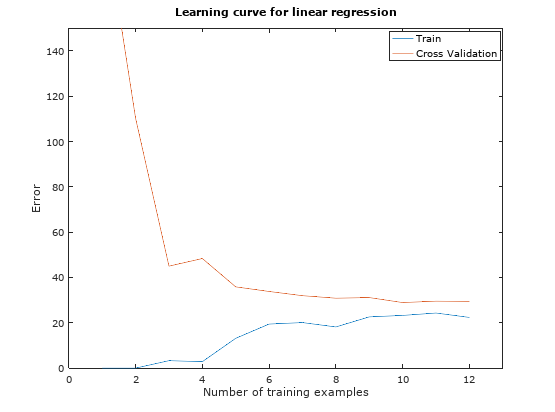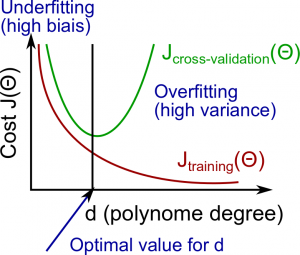Regularized Linear Regression vs Regularized Polynomial Regression and Bias-Variance Trade-off
Hello everyone, Happy 2018 and welcome back!
Up until now, we have discussed a few interesting machine learning algorithms that is capable of solving complex problems. Although it is important to understand the underlying mathematical theory of each algorithm, we should also begin to question, how can we further improve our algorithm? If we discover that our algorithm is under-performing (i.e. the margin of errors are big), what should we do?
According to Andrew, errors in our predictions can be troubleshooted by:
- Getting more training examples
- Trying smaller sets of features
- Trying additional features
- Trying polynomial features
- Increasing or decreasing
We will delve into diagnostic techniques for choosing one of the above solutions in this post! We will implement regularized linear regression to predict the amount of water flowing out of a dam using the change of water level in a reservoir, then we will apply it to examine models with different bias-variance properties.
In previous post, we have discussed pretty much on how well our algorithm are trained. This gave us a good idea on how it worked on the training set, but we have no idea on how well the algorithm is performing in our test set. To work it out, we will first divide our dataset into three different parts, with 60% of training set, 20% of cross validation set, and 20% of test set:
- Training set (where our model learn on
X,y) - 60% - Cross validation set (where regularization parameter
Xvalandyvalare determined) - 20% - Test set (where the performance is evaluated. These are unseen examples which our model did not see during training:
Xtest,ytest) - 20%
However, splitting based on this percentage is subjective and might varies according to situation. There are few good discussions on how should we split our dataset on CrossValidated that is worth reading for more comprehensive understanding towards this subject.
Back to our Regularized Linear Regression problem, we will first visualize our data by plotting it out.
% Plot training data
plot(X, y, 'rx', 'MarkerSize', 10, 'LineWidth', 1.5);
xlabel('Change in water level (x)');
ylabel('Water flowing out of the dam (y)');
Figure 1: Visualizing the data
Recall that regularized linear regression has the following cost function
Correspondingly, the partial derivative of regularized linear regression’s cost for is defined as
where refers to the regularization parameter which governs the degree of regularization. This regularization term puts a penalty on the overall cost value , that is, when the magnitudes of the model parameters increases, the penalty increases too. When is initialized to theta=[1;1], we expect our cost value to be approximately at 303.99.
%MATLAB/OCTAVE Implementation
% fraction of linearRegCostFunction function
%cost function
J = (1/(2*m))*sum(power((X*theta - y),2))+ (lambda/(2*m)) * sum(power(theta(2:end),2));
% for j >=1
regularized = (lambda/m) .* theta;
% for j = 0
regularized(1) = 0;
grad = ((1/m) .* X' * (X*theta - y)) + regularized;
Cost at theta = [1 ; 1]: 303.993192
Since the dataset is of such low dimension , where we are trying to fit a 2D , regularization will not be playing a crucial part, we will set our regularization parameter = 0 for this part. Furthermore, when plotting the best fit line to our data in Figure 2, we notice that it is not a good fit to the data since the data is non-linear in nature. To fit this dataset better, we will use polynomial regression in later part. We will first implement a function to generate learning curves that can help us debug our learning algorithm.
Figure 2: Linear fit is not a a good fit to our data
Bias-Variance Trade-off
Before that, an useful concept in machine learning to bring out is the bias-variance trade-off. In simple words, a high-bias model is not complex enough for the data and might result to under-fitting. On the contrary, a high-variance model is too complex for the data and might result to over-fitting. If you are puzzled, just remember the acronym - BUVO (Bias, Under-fit; Variance, Over-fit) !
Learning Curves
Learning curves basically plots training and cross validation error as a function of training set size and it is a useful method in debugging learning algorithms, where the error function for our training set is defined as
Similarly, our error function for our cross validation set is defined as
for i = 1:m
% splitting training dataset
X_train = X(1:i, :);
y_train = y(1:i, :);
theta = trainLinearReg(X_train, y_train, lambda);
error_train(i) = linearRegCostFunction(X_train, y_train, theta, 0);
error_val(i) = linearRegCostFunction(Xval, yval, theta, 0);
Once implemented, the error of the training set and cross validation set will be computed and the learning can be plotted out and will look like in Figure 3.
% Computing the first train error of training set and cross validation set for linear regression
# Training Examples Train Error Cross Validation Error
1 0.000000 205.121096
2 0.000000 110.300366
3 3.286595 45.010231
4 2.842678 48.368911
5 13.154049 35.865165
6 19.443963 33.829962
7 20.098522 31.970986
8 18.172859 30.862446
9 22.609405 31.135998
10 23.261462 28.936207
11 24.317250 29.551432
12 22.373906 29.433818
 Figure 3: Linear regression learning curve
Figure 3: Linear regression learning curve
Notice that as the number of training examples increase, both training set error and cross validation error remained at a high error value. This indicates a high bias problem in our model, where the linear regression model is under-fitting and is unable to fit our dataset very well. To obtain a better fit to our model, we will introduce polynomial regression.
Polynomial Regression
In simple words, polynomial regression add more features to our hypothesis such that
where is the feature of your dataset. Let’s say we want to map our hypothesis to the polynomial, we can do this by
for i = 1:p
X_poly(:,i) = X.^i;
end
In this post, we will use a polynomial degree of 8 for the sake of discussion, where feature normalization is applied to scale our dataset better. Once the parameters are learnt using =0, we can compute the training set and cross validation set error and plot the polynomial fit and the learning curve as depicted in Figure 4 and Figure 5.
% Computing the first train error of training set and cross validation set for polynomial regression
# Training Examples Train Error Cross Validation Error
1 0.000000 160.721900
2 0.000000 160.121510
3 0.000000 61.754825
4 0.000000 61.928895
5 0.000000 6.597913
6 0.000191 10.239934
7 0.040538 8.039769
8 0.076369 5.293786
9 0.162867 7.196048
10 0.150745 8.828604
11 0.162416 10.133383
12 0.084463 7.734434
Figure 4: Polynomial fit when =
0
Figure 5: Polynomial learning curve when =
0
Comparing these set of output relative to the ones we obtained using linear regression model, we observe a better fitting of the model to the dataset and the learning curve is able to records very little errors as the number of training data increases. However this is another typical example of over-fitting. Hence, we will need to consider regularization in this case, where we will tune the polynomial fitting and learning curve using different value for , where = 0.1, 1, 3,10 and 100 respectively. Figure 6 compares the result of each value.
Figure 6: Polynomial fittings and learning curves when =
[0.1,1,3,10,100]
It is obvious that the value of can significantly affect the results of regularized polynomial regression on the training set and cross validation set. A model without regularization or small regularization fits the training set well, but does not generalize well, causing over-fitting. On the contrary, a model with too much regularization does not fits the training set well, causing under-fitting. A better choice of will the ones when = 1 or 3.
Conclusion
As discussed here, plotting the learning curves to understand what problem (whether a bias or variance problem) our current dataset is experiencing is a crucial procedure to understand how well our machine learning algorithm is working. To recap, remember
High Bias = Under-fitting (BU): both and will be high. Also,
High Variance = Over-fitting (VO): will be low and will be much greater than
 Figure 7: BU-VO!
Figure 7: BU-VO!
To conclude, the following table summarizes the different approaches one way consider when debugging a learning algorithm.
| Fixes Problem of | |
|---|---|
| Get more training examples | High Variance |
| Try smaller sets of features | High Variance |
| Try getting additional features | High Bias |
| Try adding polynomial features | High Bias |
| Try decreasing | High Bias |
| Try increasing | High Variance |